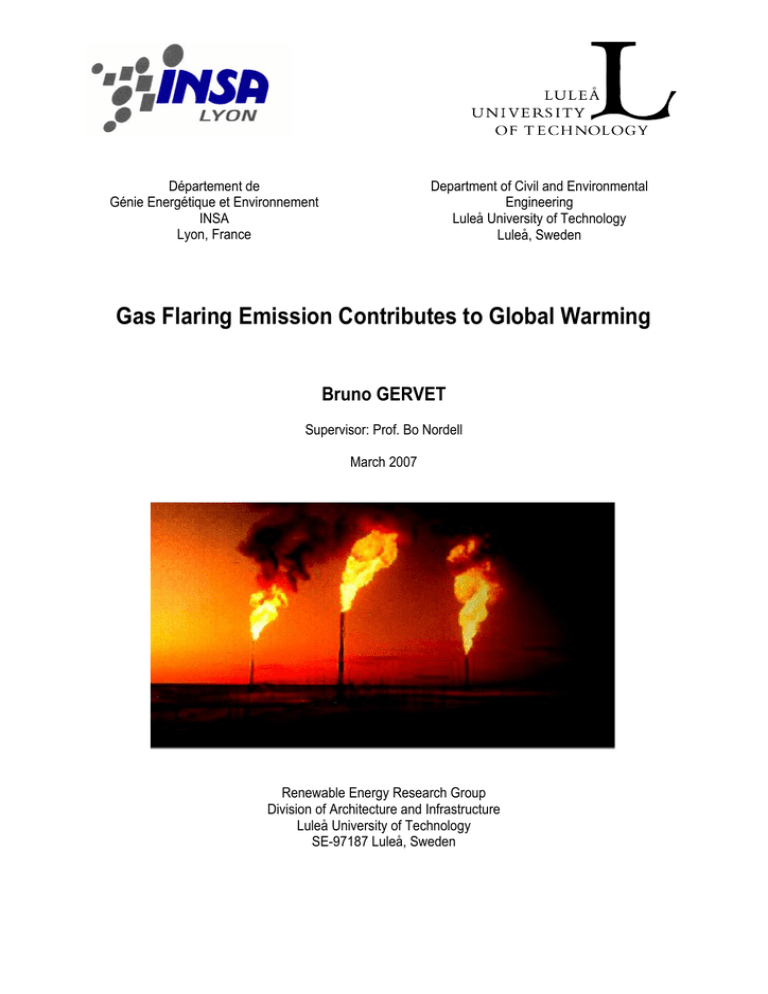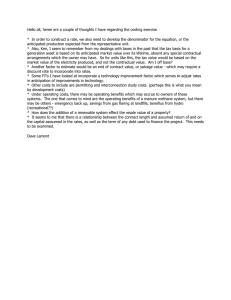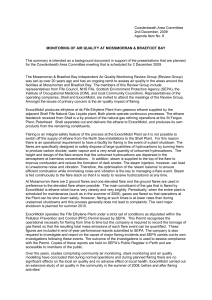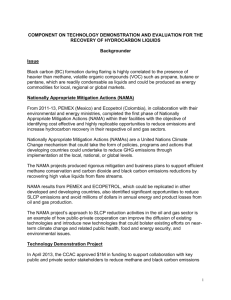Gas Flaring Emission Contributes to Global Warming
advertisement

Département de Génie Energétique et Environnement INSA Lyon, France Department of Civil and Environmental Engineering Luleå University of Technology Luleå, Sweden Gas Flaring Emission Contributes to Global Warming Bruno GERVET Supervisor: Prof. Bo Nordell March 2007 Renewable Energy Research Group Division of Architecture and Infrastructure Luleå University of Technology SE-97187 Luleå, Sweden Gas Flaring Emission Contributes to Global Warming 1. Net Heat Generation from Gas Flaring 1.1. Background Although global warming is scientifically accepted, its cause is still disputed. Nordell (2003) suggested a most natural explanation; that this warming is a result of heat emissions from the global consumption of non-renewable energy. Global warming means that heat has been accumulating in air, ground, and water since 1880. During the same period heat was released into the atmosphere by heat dissipation from the global use of fossil fuel and nuclear power. Any such thermal pollution must contribute to the warming. A comparison of accumulated and emitted heat show that heat emissions explains 55% of the global warming. Moreover, the amount of emitted heat is underestimated, since the non-commercial use of fossil fuel is not included, e.g. gas flares, underground coal fires, oil used in production of plastics, and also biofuel (wood) consumed at a greater rate than the growth. Here, the task was to estimate the heating caused by one of the non-commercial energy sources, the flaring of gas. 1.2. Definition The flared gas is gas burnt off as unusable waste gas or flammable gas, which is released by pressure relief valves during unplanned over-pressuring of plant equipment. It burns through a gas flare (an elevated vertical chimney, see picture 1.1) on oil wells, in refineries, or in chemical plants. Pict. 1.1. Gas flare at an oil refinery. In oil production wells, refineries, and chemical plants the primary purpose of gas flaring is to act as a safety device to protect vessels or pipes from over-pressuring due to unplanned upsets. Whenever the plant equipment items are over-pressured, pressure relief valves automatically releases gas (and sometimes also liquids). The released gases and/or liquids are burnt as they exit the flare chimney. The size and brightness of the resulting flame depend upon the amount of released flammable material. Steam can be injected into the flame to reduce the formation of black smoke. In order to keep the flare system functional, a small amount of gas is continuously burnt, like a pilot light, so that the system is always ready for its primary purpose as an over-pressure safety system [1]. -2- Gas Flaring Emission Contributes to Global Warming 1.3. Gas Flaring Emissions Flaring is a high-temperature oxidation process used to burn combustible components, mostly hydrocarbons, of waste gases from industrial operations. Natural gas, propane, ethylene, propylene, butadiene and butane constitute >95% of the waste gases flared. In combustion, gaseous hydrocarbons react with atmospheric oxygen to form carbon dioxide (CO2) and water. In some waste gases, carbon monoxide (CO) is the major combustible component. During a combustion reaction, several intermediate products are formed, and eventually, most of them are converted to CO2 and water. Some quantities of stable intermediate products such as carbon monoxide, hydrogen, and hydrocarbons will escape as emissions (See Picture 1.2). Gases flared in refineries, petroleum production, chemical industries, and to some extent from coke ovens, are composed largely of low molecular weight hydrocarbons with high heating value [2]. Pict. 1.2. Gas flaring in Kuwait (Photo: Pembina Institute). The method for estimating emissions from natural gas flaring is based on the volume of vented and flared gas reported to EIA (assuming that all gas is flared). To calculate carbon emissions, the figures are aggregated, converted into Btu, and then multiplied by an emissions coefficient of 14.92 million metric tons of carbon per quadrillion Btu [3]. It is widely acknowledged that flaring and venting of gas contribute significantly to greenhouse gas (GHG) emissions, with negative impacts on the environment. Today, its contribution to greenhouse gases has declined by three-quarters in absolute terms, after its peak in the 1970s. The World Bank estimates that the annual amount of natural flared or vented (un-burnt) gas is equivalent to the combined annual gas consumption of Germany and France, twice the annual gas consumption of Africa, three quarters of the Russian gas export, or enough to supply the entire world with gas for 20 days. This flaring is geographically concentrated: 10 countries account for 75% of emissions, and twenty for 90%. The largest flaring operations occur in the Niger Delta region of Nigeria (See Picture 1.3). -3- Gas Flaring Emission Contributes to Global Warming Pict. 1.3. Gas flare in the Niger Delta. 1.4. Top 20 flaring countries Tab. 1.4, Top 20 flaring countries. 2004 Rank 1 2 3 4 5 6 7 8 9 Country Nigeria Russia (total Khanty Mansiysk (KM) Russia (excluding KM) Iran Iraq Angola Qatar Algeria Venezuela Equatorial Guinea Total Top 20 Reported Flaring 2004* 2004 Rank 24.1 14.7 6.4 10 11 12 Indonesia USA Kazkhstan 8.3 13 Libya 13.3 8.6 6.8 4.5 4.3 3.7** 3.6 14 15 16 17 18 19 20 Azerbaijan Mexico UK Brazil Gabon Cameroon Canada Country Reported Flaring 2004* 3.5** 2.8 2.7 2.5 2.5 1.6 1.6 1.5** 1.4 1.1 1.0 107.5 *Source: GGFR **These figures, expressed in billion cubic meters (bcm) may include some venting as well, due to unavailability of segregated data. When crude oil is extracted from the earth, natural gas associated with the oil is produced to the surface as well. In areas of the world lacking infrastructure and markets, this associated gas is usually flared or sometimes vented. According to the figure 1.5: Africa 30%, The Americas 10%, Middle East 25%, Russian Federation and Central Asia 20%, Asia 7.5%, Europe 3% of the world gas flaring. -4- Gas Flaring Emission Contributes to Global Warming Fig. 1.5, Satellite picture of the world showing gas flares (shown as red dots) for the year 1994, GGFR, World Bank Group, 2001. 1.5. Crude Oil Production, 1880-2000 The aim is to estimate flared gas from 1880 (start of global warming) to 2000. Based on available data, the amount of gas flaring is evaluated from the CO2 emission that it generates. It is also interpolated from the World Crude Oil Production. It is similar to study the gas flaring from emission or production of crude oil (See Graph 1.6). Emission and Production of Crude Oil 30000 3500 25000 3000 2000 15000 1500 10000 Mt of Carbon 2500 20000 World Crude oil production (Mbbl) World CO2 emission from crude oil production (Mt of C) 1000 5000 500 0 0 1880 1930 1962 1970 1978 1986 1994 2002 Years Graph 1.6, CO2 Emission and Production of Crude Oil versus Years (1880-2003). The main source for the Crude oil Production is EIA (Energy Information Administration, Appendix 2). Unfortunately, this administration does not have any data before 1980. The data between 1880 and 1980 comes from another source [4] that seems reliable according to the graph 1.7. -5- Gas Flaring Emission Contributes to Global Warming World Crude Oil Production 23000 21000 19000 17000 from the source (7) From EIA 15000 13000 11000 9000 7000 1960 1965 1970 1975 1980 Year Graph 1.7, World Crude Oil Production versus Year between 1960 and 1984, from two different sources. 1.6. CO2 Emissions of Gas Flaring The difficulty to evaluate the gas flaring emission is to find out the most reliable database and to understand why these databases show different data. The first database is from EIA (Energy Information Administration, Appendix 2). The gas flaring emission is obtained by comparing the World Carbon Dioxide Emissions from the Consumption and Flaring of Natural Gas, and the World Carbon Dioxide Emissions from the Consumption of Natural Gas. The second database is from CDIAC (Carbon Dioxide Information Analysis Centre, Appendix 3). Here, the gas flaring emission is given. The CDIAC is really interesting because the database starts in 1950, whereas the EIA’s database starts in 1980. Moreover, all flared gas emissions since 1950 from are recorded, from the production of cement, crude oil, coal and natural gas. However, there are some uncertainties to consider, as developed in section 1.7. It is not possible to get data before 1950 from which year the recording of CO2 emissions started, (D. Kaiser, CDIAC). Gas flaring (Mt C) 120 100 80 From CDIAC From EIA 60 40 20 0 1940 1950 1960 1970 1980 1990 2000 2010 Year Graph 1.8, CO2 Emission from Gas flaring versus Years, from two different sources (1950-2003). -6- Gas Flaring Emission Contributes to Global Warming Figure 1.8 shows a difference between the two curves, from 1986. On the other hand, the curves are quite similar between 1980 and 1986, considering some uncertainties. In fact, the CDIAC’s database contains global annual estimates of CO2 emissions resulting from gas flaring in only oil fields for 1950-2003 [5], whereas the EIA’s database results from gas flaring in oil fields and in some gas plants. EIA has no authority to require data from the plants; the database only contains the data that it was provided to them (EIA, Appendix 2). Moreover, nowadays, a great part of flared or vented gas is emitted by Liquefaction Natural Gas (LNG) plants (F.-R. Mouton, World Bank, Appendix 1). The LNG production started in 1969. It is most likely that the difference between the two curves results from LNG production, among others things. In 2004, 25% of the gas flaring in Algeria came from LNG plants. Another important reason that should be taken into account is the Iraq-Kuwait conflict in 1990. Indeed, this war involved that lots of oil was burnt, and lots of gas was flared or vented. It is well established that the flared gas decreases since 1980. A concrete example of this win approach is the experience of Saudi Arabia in the Middle East. There gas flaring emissions fell from 38 billion cubic meters per year in the early 1980s to about 120 million cubic meters per year in 2004. The associated gas is used to provide the basis of a successful petrochemicals industry. As a result, Saudi Arabia is now one of the world’s largest producers of urea, a widely used agricultural fertilizer, and many other Middle Eastern nations are following suit. Even if the flared gas decreases in an oil field, the World’s total gas flaring is constant due to the world crude oil consumption increase. That is an opinion presented at most conferences on gas flaring (Fighting poverty and pollution with energy, Side event on international initiative on reduced flaring of natural gas, Marrakech 8 November 2001. Global Forum on Flaring & Gas Utilization, Paris, December 13th, 2006 - GGFR, Appendix 1). Finally, according to the different points developed above, the curve considering the maximum of the both curves are used (Graph 1.9). Gas flaring (Mt C) 120,00 100,00 80,00 60,00 40,00 20,00 0,00 1940 1950 1960 1970 1980 1990 2000 2010 Year Graph 1.9, CO2 Emission from Gas flaring versus Years, considering the maximum of Graph 1.8’s curves. -7- Gas Flaring Emission Contributes to Global Warming 1.7. Results From the Graph 1.6 and Graph 1.9, we establish the curve Graph 1.10. In the seventies, the gas flaring emission reached a peak. For some nations (e.g., Kuwait, Oman), CO2 emissions from gas flaring constitute a sizeable portion of their total CO2 emissions; these emissions were particularly high during the 1960s and 1970s because of a lack of infrastructure and a large global demand. Graph 1.11 shows the percentage of gas flaring emissions versus the world crude oil production emissions, throughout the years. This graph represents the amelioration of gas flaring systems. We can notice two clear and distinct increases in flaring; the one in the seventies is due to a high world oil demand and the one in nineties is due to the Iraq-Kuwait war. In 1991, conflict in the Middle East resulted in large quantities of oil and gas being ignited at oil fields in Kuwait. The amount of CO2 released by these fires is about 130 million metric tons of Carbon (U.S. National Oceanic and Atmospheric Administration). Emissions from gas flaring declined 11% from 1991 to 1992, due largely to the end of the Iraq-Kuwait conflict. 3500 120,00 3000 100,00 2500 80,00 2000 60,00 1500 40,00 1000 Mt of Carbon CO2 gas flaring emission (Mt of Carbon) Oil Production Gas flaring 20,00 500 0 1950 0,00 1960 1970 1980 1990 2000 Year Graph 1.10, CO2 Emission from Gas flaring and from World Crude Oil Production versus Years (1950-2003). 6 % of gas flaring emission/ World crude oil production emission 5 4 3 2 1 0 1950 1960 1970 1980 1990 2000 Year Graph 1.11, % of Gas Flaring emission / World Crude Oil Production Emission versus Years (1950-2003). -8- Gas Flaring Emission Contributes to Global Warming Flared gas before 1950 is estimated by interpolating of the curve in Graph 1.11 This interpolation is based on the crude oil production curve, because this is the main gas flaring source before 1950. It seems clear that in 1950 the quantity of flared gas for a mean quantity of crude oil produced is far less than in 1880. From this assumption, there is different ways to interpolate the curve. From the CDIAC’s database, we can get an estimation of flared gas for almost all countries since around 1950. Thus, we will pay attention to the most pollutant countries. According to Table 1.12 and graph 1.11, only values before 1967 are considered. After that the gas flared was too influenced by the world demand increase. Tab 1.12. % of gas flaring emission / world crude oil production emission for the most pollutant countries. %** Nigeria (1963) Angola (1970) Algeria (1970) Libya (1967) Saudi Arabia (1967) Oman (1971) UAE* (1969) Iraq (1965) Iran (1955) Indonesia (1970) Venezuela (1950) Mexico (1950) USA (1950) 46 87 97 656 418 680 13820 120 405 13 351 11 4.8 * UAE: United Arab Emirates. ** % of gas flaring emission / world crude oil production emission. The four different ways to interpolate are (Graph 1.13): - The percentage of gas flaring emission / world crude oil production emission in 1880 is the same than the most pollutant country. (1) - The percentage of gas flaring emission / world crude oil production emission in 1880 is the same than the average of the percentage for the most pollutant countries. (2) - The percentage of gas flaring emission / world crude oil production emission between 1880 and 1965 is linear. (3) - The percentage of gas flaring emission / world crude oil production emission in 1880 is the same than in 1950. (4) CO2 gas flaring emission 120 100 80 (4) (3) (2) (1) 60 40 20 0 1870 1890 1910 1930 1950 1970 1990 Year Graph 1.13, CO2 Gas flaring Emission versus year, for different case (1870-2003). -9- Gas Flaring Emission Contributes to Global Warming From the Graph 1.13, we obtain the CO2 gas flaring emission and the amount of flared gas (Tab 1.14). The flared gas was estimated from the EIA’s data [3] (Gas flaring = 14,92 106 t of C/1015 (quadrillion) BTU), and also from French Wikipedia (Natural Gas = 10.85 kWh/m3 depends on the type of gas B or H). Tab 1.14. Gas Flaring, 1870 – 2003 1870 - 2003 (1) (2) (3) (4) 4569.61 4389.35 3609.94 3547.91 Gas flaring (m3) 8.259 1012 7.9333 1012 6.5246 1012 6.4125 1012 Gas flaring (kJ) 3.226 1017 3.099 1017 2.5491017 2.505 1017 CO2 gas flaring emission (Mt of C) According to the Tab 1.14, the flared gas emitted is between 6.41.1012 and 8.26.1012 m3. However, lots of uncertainties have to be considered. 1.8. Review and Uncertainty The main uncertainty results from the incomplete available data. Marland and Rotty (1984) estimated that the uncertainty of the annual global CO2 emission is 6 to 10% [5]. It is mainly due to a lack of information provided by countries such as Russia. Moreover, the data comes mainly from the oil field, neglecting the other sources, and most of operators in oil field are not required to meter gas that is vented or flared. Hence, we can understand how incomplete the database may be. On the other hand, the database does not distinguish between vented and flared gas. The vented gas is far less recorded than the flared gas. It is taken into account in the database, when it is known; the rest of the time, it is not included. The problem is that this kind of gas is directly vented into the atmosphere as methane. This gas generates then seven times more CO2 than if it was burnt (F.-R. Mouton, World Bank, Appendix 1). Its greenhouse effect is quite important. We can also consider an uncertainty from conversion such as: - Gas flaring= 14,92 106 t of C/1015 (quadrillion) BTU; - Natural Gas = 10.85 kWh/m3. If we consider the energy emitted by natural gas as 10.35 kWh/m3 (it depends on the type of gas), the uncertainty to the value of flared gas is 1.8 per cent. 1.9. Conclusion The energy released by gas flaring during the last 120 years corresponds approximately to the annual global energy consumption in 1999, i.e. 0.9.1014 kWh. This amount accounts for about 3% of missing net heat generation and for 1.2% of total net heat generation, considering the - 10 - Gas Flaring Emission Contributes to Global Warming worst case (1). Graph 1.15 shows the gas flaring emission for the worst case, with the crude oil production emission, since 1870. 3500 120,00 3000 100,00 2500 80,00 2000 60,00 1500 40,00 1000 Mt of Carbon CO2 emission (Mt of Carbon) Oil Production Gas flaring 20,00 500 0,00 18 70 18 80 18 90 19 00 19 10 19 20 19 30 19 40 19 50 19 60 19 70 19 80 19 90 20 00 0 Year Graph 1.15, CO2 Emission from Gas flaring and from World Crude Oil Production versus Years, for the worst case (1880-2003). Bibliography Gas Flaring [1] Nordell, B. Thermal Pollution Causes Global Warming. Global and Planetary Change. 38:305-312 (2003). [2] http://www.en.wikipedia.org/ [3] http://www.epa.gov/ttn/chief/ap42/ch13/final/c13s05.pdf [4] Appendix A, Estimation Methods (p. 9-10), Emissions of Greenhouse Gases in the United States, Energy Information Administration (EIA), 1999. [5] Moore, David S., and George P. McCabe (1989). Introduction to the Practice of Statistics. Original source: Energy Information Administration, recorded in Romer, Robert H., Energy: An Introduction to Physics, W.H. Freeman, San Francisco, 1976 for 1880 to 1972, and in The World Almanac and Book of Facts 1986 for more recent years. (http://lib.stat.cmu.edu/DASL/Datafiles/Oilproduction.html) [6] T. A. Boden, G. Marland, R. J. Andres, Estimates of Global, Regional, and National Annual CO2 Emissions from Fossil-Fuel Burning, Hydraulic Cement Production, and Gas Flaring: 1950-1992, Environmental Sciences Division Publication No. 4473, December 1995. (http://cdiac.esd.ornl.gov/epubs/ndp/ndp030/ndp0301.htm). - 11 - Gas Flaring Emission Contributes to Global Warming Appendix 1: GGFR QuickTime™ et un décompresseur TIFF (non compressé) sont requis pour visionner cette image. http://web.worldbank.org/ggfr Contact : François Régis Mouton <fmouton@worldbank.org> Launched at the World Summit on Sustainable Development in August 2002, the Global Gas Flaring Reduction public-private partnership (GGFR) brings around the table representatives of governments of oil-producing countries, state-owned companies and major international oil companies so that together they can overcome the barriers to reducing gas flaring by sharing global best practices and implementing country specific programs. The GGFR partnership, a World Bank-led initiative, facilitates and supports national efforts to use currently flared gas by promoting effective regulatory frameworks and tackling the constraints on gas utilization, such as insufficient infrastructure and poor access to local and international energy markets, particularly in developing countries. Poverty reduction is also an integral part of the GGFR program, which is developing concepts for how local communities close to the flaring sites can use natural gas and liquefied petroleum gas (LPG) that may otherwise be flared and wasted. The program has already evaluated opportunities for small-scale gas utilization in several countries. GGFR delivers results - - - - Ten major oil companies, the OPEC Secretariat and 14 countries that contribute a significant share of the world’s total flaring (about 70 percent) have already joined GGFR. The majority of partners have endorsed a Global Standard for gas flaring reduction. GGFR is implementing demonstration projects for associated gas utilization in eight countries. GGFR is assisting Algeria, Cameroon, Equatorial Guinea, Kazakhstan, Nigeria, and Qatar to meet identified dates for zero flaring, through increased collaboration between operators, the national oil company and the regulator. Potential avoided flared gas, through GGFR facilitated carbon projects, is approximately 12 billion cubic meters per year (or 423 billion cubic feet), equivalent to 115 million tons of CO2 emissions reduction by 2012. GGFR has developed a unique web-based tool to report flared and vented data by country. The data tool will be implemented in GGFR partner countries, starting with Cameroon, Nigeria, Algeria and Qatar. - 12 - Gas Flaring Emission Contributes to Global Warming Appendix 2: EIA – Energy Information Administration. [1] http://www.eia.doe.gov/ [2] Highlights of GAO-04-809, a report to the Honorable Jeff Bingaman, Ranking Minority Member, Committee on Energy and Natural Resources, U.S. Senate Reduce Emissions. The Energy Information Administration (EIA), created by Congress in 1977, is a statistical agency of the U.S. Department of Energy. Their mission is to provide policy-independent data, forecasts, and analyses to promote sound policy making, efficient markets, and public understanding regarding energy and its interaction with the economy and the environment. EIA is the Nation’s premier source of unbiased energy data, analysis and forecasting. By law, EIA’s products are prepared independently of Administration policy considerations. EIA neither formulates nor advocates any policy conclusions. EIA issues a wide range of weekly, monthly and annual reports on energy production, stocks, demand, imports, exports, and prices, and prepares analyses and special reports on topics of current interest [1]. Who uses EIA’s products? EIA’s data and analyses are widely used by Federal and state agencies, industry, media, researchers, consumers, and educators. All of EIA’s products can be accessed through its Web site, http://www.eia.doe.gov, which logs more than 2 million user sessions a month [1]. Review “ First, the Department of Energy’s Energy Information Administration (EIA) collects and reports data voluntarily provided by oil- and gas-producing states. Because EIA has no authority to require states to report, some do not, leading to incomplete data. Second, EIA has provided limited guidance to states to promote consistent reporting. As a result, only about one-fourth of the states reporting provide data that EIA considers consistent. Third, the data EIA collects do not distinguish between flared gas and vented gas—an important distinction since they have dramatically different environmental impacts. Data on flaring and venting outside the United States are also limited, since many countries report unreliable data or none at all. To improve data on flaring and venting, EIA could use its authority to collect data directly from oil and gas producers; to obtain more consistent data, EIA could improve its guidelines for reporting. From an environmental perspective, EIA, the Minerals Management Service, and the Bureau of Land Management could require flaring and venting data to be reported separately from each other. Globally, the federal government could set an example by continuing to improve U.S. data, continuing to support global efforts, and using U.S. satellite data to detect unreported flaring” [2]. - 13 - Gas Flaring Emission Contributes to Global Warming Appendix 3: CDIAC http://cdiac.ornl.gov/ Contact : Dale Kaiser <kaiserdp@ornl.gov> The Carbon Dioxide Information Analysis Center (CDIAC) is the primary climate-change data and information analysis centre of the U.S. Department of Energy (DOE) since 1982. CDIAC is located at DOE's Oak Ridge National Laboratory (ORNL) and includes the World Data Centre for Atmospheric Trace Gases. CDIAC's data holdings include records of the concentrations of carbon dioxide and other radiatively active gases in the atmosphere; the role of the terrestrial biosphere and the oceans in the biogeochemical cycles of greenhouse gases; emissions of carbon dioxide to the atmosphere; long-term climate trends; the effects of elevated carbon dioxide on vegetation; and the vulnerability of coastal areas to rising sea level. CDIAC provides data management support for major projects, including the AmeriFlux Network, continuous observations of ecosystem level exchanges of CO2, water, energy and momentum at different time scales for sites in the Americas. CDIAC is supported by DOE's Climate Change Research Division of the Office of Biological and Environmental Research. CDIAC responds to data and information requests from users worldwide investigating the greenhouse effect and global climate change. The CO2-emissions database is derived from a variety of sources and requires considerable data processing, selection, and integration. Each of the data sets used for calculating the CO2emission estimates is checked carefully. CDIAC works with the UN Statistical Division annually to quality assure each new version of the UNSTAT Database. Although the review process is unable to detect some kinds of data problems, it does confirm that the UNSTAT Database meets high standards of data management and internal consistency. - 14 -






